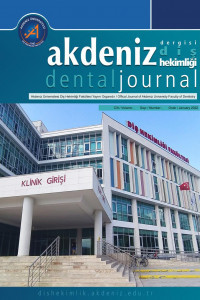Diş Plağının Gösterilmesinin Üniversite Öğrencilerinin Ağız Diş Sağlığına Yönelik Tutum ve Davranışlarına Olan Etkisinin Değerlendirilmesi
Ağız Hijyeni, Ağız ve Diş Sağlığı Davranışları, HU-DBI, Plak boyama
Evaluation of the Effect of Display of Dental Plaque on Oral and Dental Health Behaviors of University Students
HU-DBI, Oral Hygiene, Oral and Dental Health Behaviors, Plaque disclosing,
___
- REFERANSLAR 1. Executive Board, 148. (2020). Oral health; Achieving better oral health as part of the universal health coverage and noncommunicable disease agendas towards 2030. World Health Organization. https://apps.who.int/gb/ebwha/pdf_files/EB148/B148_8-en.pdf (Erişim tarihi 01.07.2022).
- 2. Global Burden of Disease Collaborative Network. Global Burden of Disease Study 2019 (GBD 2019). Seattle: Institute of Health Metrics and Evaluation (IHME); 2020
- 3. Petersen PE, Bourgeois D, Ogawa H, Estupinan- Day S, Ndiaye C. The global burden of oral diseases and risks to oral health. Bull World Health Organ. 2005;83:661-669.
- 4. Dündar, N., Çal, A. & Erkoca, S. Üniversite Öğrencilerinin Ağız Diş Sağlığı Davranışlarına İlişkin Algıları. Sürekli Tıp Eğitimi Dergisi , 2021;30(4):258-268.
- 5. Külekçi H. G., Çintan S., Dülger O. Diş hekimliğinde antimikrobiyal ağız gargaralarının kullanılması. ANKEM Derg, 1999;13(3):208-213.
- 6. Oliveira LM, Pazinatto J, Zanatta FB. Are oral hygiene instructions with aid of plaque-disclosing methods effective in improving self-performed dental plaque control? A systematic review of randomized controlled trials. Int J Dent Hyg. 2021;19(3):239-254.
- 7. Downton JM, Castaldi CR. A study of four disclosing solutions. Can Dent Hyg. Fall. 1967;6-10.
- 8. Mensi M, Scotti E, Sordillo A, Agosti R, Calza S. Plaque disclosing agent as a guide for professional biofilm removal: A randomized controlled clinical trial. Int J Dental Hygiene. 2020;18(3):285-294.
- 9. Baab D, Weinstein P. Longitudinal evaluation of a self-inspection plaque index in periodontal recall patients. J Clin Periodontol. 1968;13(4):313-318.
- 10. Kawamura M, Honkala E, Widstrom E, Komabayashi T. Cross-cultural differences of self-reported oral health behaviour in Japanese and Finnish dental students. Int Dent J 2000;50:46-50.
- 11. Kawamura M, Yip HK, Hu DY, Komabayashi T. A cross-cultural comparison of dental health attitudes and behaviour among freshman dental students in Japan, Hong Kong and West China. Int Dent J 2001;51:159-163.
- 12. Kawamura M. Dental behavioral science. The relationship between perceptions of oral health and oral status in adults. J Hiroshima Univ Dent Soc 1988;20:273-286.
- 13. Kawamura M, Spadafora A, Kim KJ, Komabayashi T. Comparison of United States and Korean dental hygiene students using the Hiroshima university-dental behavioural inventory (HU-DBI). Int Dent J 2002;52:156-162.
- 14. Kawamura M, Iwamoto Y, Wright FA. A comparison of self-reported dental health attitudes and behavior between selected Japanese and Australian students. J Dent Educ 1997;61: 354-360.
- 15. Kim KJ, Komabayashi T, Moon SE, Goo KM, Okada M, Kawamura M. Oral health attitudes/behavior and gingival self-care level of Korean dental hygiene students. J Oral Sci 2001;43:9-53.
- 16. Doğan B, Filizi K, Küçükdoğan Ü. Diş Hekimliği Öğrencilerinin Cinsiyete Bağlı Ağız Sağlığı Davranış ve Düşünceleri. GÜ Diş hek fak Derg 2009;26(2):87-93.
- 17. Özkan Şen D, Irız B, Uçan Yarkaç F, Öncü E. Diş Hekimliği Fakültesi Öğrencilerinin Periodontal Farkındalığı, Ağız Sağlığına Yönelik Tutum ve Davranışlarının Değerlendirilmesi. Neu Dent J 2020;2(1):14-24.
- 18. Peker I, Alkurt MT. Oral health attitudes and behavior among a group of Turkish dental students. Eur J Dent. 2009;3(1):24-31
- 19. Kawamura M, Wright FA, Declerck D, Freire MC, Hu DY, Honkala E, et al. An exploratory study on cultural variations in oral health attitudes, behaviour and values of freshman (firstyear) dental students. Int Dent J.2005;55(4):205-211.
- 20. Jaramillo JA, Jaramillo F, Kador I, Masuoka D, Tong L, Ahn C, Komabayashi T. A comparative study of oral health attitudes and behavior using the Hiroshima University-Dental Behavioral Inventory (HU-DBI) between dental and civil engineering students in Colombia. J Oral Sci. 2013;55(1):23-28
- 21. Kawamura M, Ikeda-Nakaoka Y, Sasahara H. An assessment of oral self-care level among Japanese dental hygiene students and general nursing students using the Hiroshima University--Dental Behavioural Inventory (HU-DBI): surveys in 1990/1999. Eur J Dent Educ. 2000;4(2):82-88.
- 22. Karem Hassan B, Jabbar Ali B, Mahmood Alwan A, Badeia RA. Self-reported oral health attitudes and behaviors, and gingival status of dental students. Clin Cosmet Investig Dent. 2020;25;12:225-232
- 23. Polychronopoulou A, Kawamura M. Oral self-care behaviours: comparing Greek and Japanese dental students. Eur J Dent Educ. 2005;9(4):164-170.
- 24. Muthu J, Priyadarshini G, Muthanandam S, Ravichndran S, Balu P. Evaluation of oral health attitude and behavior among a group of dental students in Puducherry, India: a preliminary cross-sectional study. J Indian Soc Periodontol. 2015;19(6):683-686.
- 25. Kumar H, Behura SS, Ramachandra S, Nishat R, Dash KC, Mohiddin G. Oral health knowledge, attitude, and practices among dental and medical students in Eastern India – A comparative study. J Int Soc Prev Community Dent. 2017;7(1):58-63.
- 26. Arıkan A, Pirinçci S, Keleş S, Özkan G, Abacıgil F, Okyay P. Hekim adaylarının ağız diş sağlığı alışkanlıkları ve bilgi düzeylerinin değerlendirilmesi. Atatürk Üniversitesi Diş Hekimliği Fakültesi Dergisi. 2019;29(2):189-196.
- 27. Li M, Wu Z, Zhang R, Lei L, Ye S, Cheng R, et al. Comparison of oral health behaviour between dental and non-dental undergraduates in a university in southwestern China-exploring the future priority for oral health education. BMC Oral Health. 2020;20(1):1-11.
- 28. American Psychological Association. Education & Socioeconomic Status, 2012. http://www.apa.org/pi/ses/resources/publications/factsheet-education.aspx (Erişim tarihi 01.07.2022).
- Başlangıç: 2022
- Yayıncı: Akdeniz Üniversitesi
Çift Taraflı Bifid Mandibular Kondil: Bir Olgu Sunumu
Rümeysa ŞENDİŞÇİ, Ali RASAT, Hümeyra TERCANLI ALKIŞ
Damla KIRICI, Ayşe Nur KUŞUÇAR, Duygu KOLAY
Ecem MAMAKLI, Ayşe CENGİZ, Havva AKDAĞ, Gamze CESUR, Seher YAŞAR, Erim ALTUNER, Burcu BUDAK, Muhammed Emin UÇAK, Tayyip İSLAMOĞLU, Hasan AKIN, Burak ISTIL, Hüseyin KARAYILMAZ
Çağatay BARUTÇUGİL, Merve KOZAN TUNCER, Ayşe DÜNDAR
Diş hekimliği Fakültesi Öğrencilerinde Kas İskelet Sistemi Problemlerinin Değerlendirilmesi
Özlem DALTABAN, Hazal DURMUŞ, Onur METE, Yasin Ramazan ERYILMAZ, Yasin GÖKAL, Yağmur KARAHAN, Büşra İpek ENGİN, İlknur BAYDUR, İlknur SAYDIN, Betül GÜMÜŞ, Kübra KERPİÇCİ
Posterior Mandibulada Fibröz Displazi: Bir Olgu Sunumu
Zeliha Merve ERTUĞRUL, Bilay STEVANOVIC SANCAR, Hümeyra TERCANLI ALKIŞ
